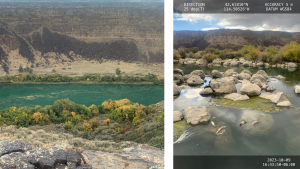Quagga Mussels - FOUND AGAIN, Oh No!
[NOTE: This blog was drafted prior to the Idaho State Department of Agriculture's September 24, 2024 announcement that quagga mussel DNA has been found in the Snake River. The blog has been updated. Check the ISDA website for up-to-date information on treatment plans closures, and more.]Exactly one year ago, the Idaho State Department of Agriculture (ISDA) discovered the presence of highly invasive quagga mussels in the Snake River near Twin Falls. Given the threat, the state immediately mobilized a response and carried out one of the most complicated invasive species control efforts ever attempted.This was the first time that quagga mussels had been discovered in Idaho, or the entire Columbia River Basin. As a highly-competitive and non-native species, they threatened to spread rapidly, and studies have estimated costs to Idaho at $100 million annually. The stakes were high. Idaho spent $1.6 million to buy 40,000 gallons of copper-based snail-killing chemicals (known as molluscicide) to apply in a 6-7 mile section of the river, which also unfortunately resulted in large scale vegetation and fish kills, including 100% of the sturgeon in this reach of river, and thousands of other native fish and shellfish. Birds and other wildlife were not expected to be impacted, and ICL did not receive any reports.
Idaho spent $1.6 million to buy 40,000 gallons of copper-based snail-killing chemicals (known as molluscicide) to apply in a 6-7 mile section of the river, which also unfortunately resulted in large scale vegetation and fish kills, including 100% of the sturgeon in this reach of river, and thousands of other native fish and shellfish. Birds and other wildlife were not expected to be impacted, and ICL did not receive any reports.
So…Did it work?
Unfortunately, it did not.Quaggas only become active once water temperatures hit 47 degrees, so ISDA wasn’t able to test for their presence during the winter. But all summer long, the ISDA has been testing the Snake River for quagga mussel DNA, and until September 24, 2024, there had been no indication that quagga mussels survived. One female quagga can release 1 million eggs per year, and one male can release 200 million sperm, so the state is once again assembling a rapid response plan and expects treatments to begin by mid-October.
What about the long-term effects?
According to ISDA, the Idaho Department of Fish & Game, Department of Environmental Quality and others, there are not any long-term negative impacts associated with the use of this pesticide. Short-term effects included killing thousands of fish, snails, and native shellfish, along with aquatic vegetation. As that vegetation died, it pulled oxygen out of the water as it decomposed, leading to additional fish mortality.Unfortunately, with the re-discovery of quagga mussels, the treatment will be repeated and any future restoration or restocking efforts will have to wait.
What can we learn?
One thing we've learned is that we all have a role to play to ensure that we keep quagga mussels and other invasive species out of our waters. The potential disruption to the economy and ecology are severe.We also learned that while we may not like having to poison 7 miles of the Snake River, the alternative of allowing invasive mussels to get a foothold in the Snake River may simply be too risky. While we were hopeful that the 2023 treatment was successful, it appears that another round of treatment may be necessary to prevent further spread and ongoing treatment in future years.We also learned that we must remain watchful. The small number of mussel larvae that were detected is a hopeful sign that the population remains small. ISDA was only able to re-discover the mussels because of additional resources. The state has stepped up monitoring, new check stations, and provided hot-washes for boats to clean out any viable mussels. Despite education and outreach efforts, ISDA still intercepted 20 contaminated boats this year. Any one of those boats could force a costly repeat of the effort to Idaho's water bodies of quagga mussels.As a result, we urge all boaters to be aware of the risk, to stop at check stations and to thoroughly clean your boat before dropping it into any rivers, lakes, or reservoirs in Idaho.
Support ICL’s initiative to restore the Snake River across southern Idaho to a safe, fishable, swimmable condition by becoming an ICL member today!


